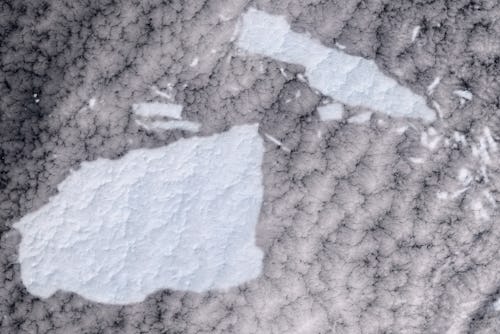A massive iceberg chunk is dumping billions of tons of water into the ocean
You might not think more water in the ocean is a big deal, but it is.

In 2017, one of the largest icebergs in the world — the A-68 iceberg in Antarctica — went the way of every boy band ever and broke up. The solo career of one of the chunks off that massive block of ice, A-68a, has been a harrowing one. The former piece of iceshelf, once spanning 2,240 square miles and 761 feet thick, drifted dangerously close to the island of South Georgia — threatening to scrape the sea floor in the process — before eventually burning out. But, while the main crisis was avoided when the iceberg missed South Georgia and managed to avoid getting stuck, the impact of this huge hunk of out of place ice is just starting to be understood.
On Thursday, the European Space Agency revealed that A-68a has been flooding the ocean. As the iceberg melts from the warmer waters that it’s sitting in now, it has released a massive 168 billion tons of freshwater. According to the University of Leeds, that’s about 20 times the amount of water that occupies Loch Ness, or more water than it would take to fill 61 million Olympic-size swimming pools. It’s ... a lot.
It’s also not great for the surrounding ecosystems in South Georgia. While the melting, which was identified by the Center for Polar Observation and Modelling (CPOM) and British Antarctic Survey (BAS) via satellite measurements, was probably necessary in order to keep the iceberg from scraping the sea floor and causing irreparable damage, it’s also causing new problems. Packed into all that freshwater is a whole bunch of nutrients from the ocean that are not native to the sensitive ecosystem surrounding South Georgia.
The tiny island is surprisingly dense with at-risk and endangered species. It is home to seals, penguins, and birds, and serves as a feeding ground for migrating whales. The sudden influx of lots and lots of water packed with unfamiliar nutrients is going to have an impact on those creatures and their environment — though researchers aren’t sure if it will be a net positive or potentially destructive. Some experts have suggested that dust contained in the ice could help to fertilize plankton and improve the availability of food in the region. The ESA noted that the release of water will “[influence] the local ocean circulation,” and that scientists will have to keep watching to track the effects.
What ends up happening with A-68a is important, because it likely won’t be the last rogue iceberg to float its way into uncharted territory. Researchers noted that the path the block of former iceshelf ended up taking could be one that future iceberg splinters follow, too, and those will similarly affect the oceans they end up in. With A-68a, we’re basically living through a science experiment. Let’s hope it has positive effects.